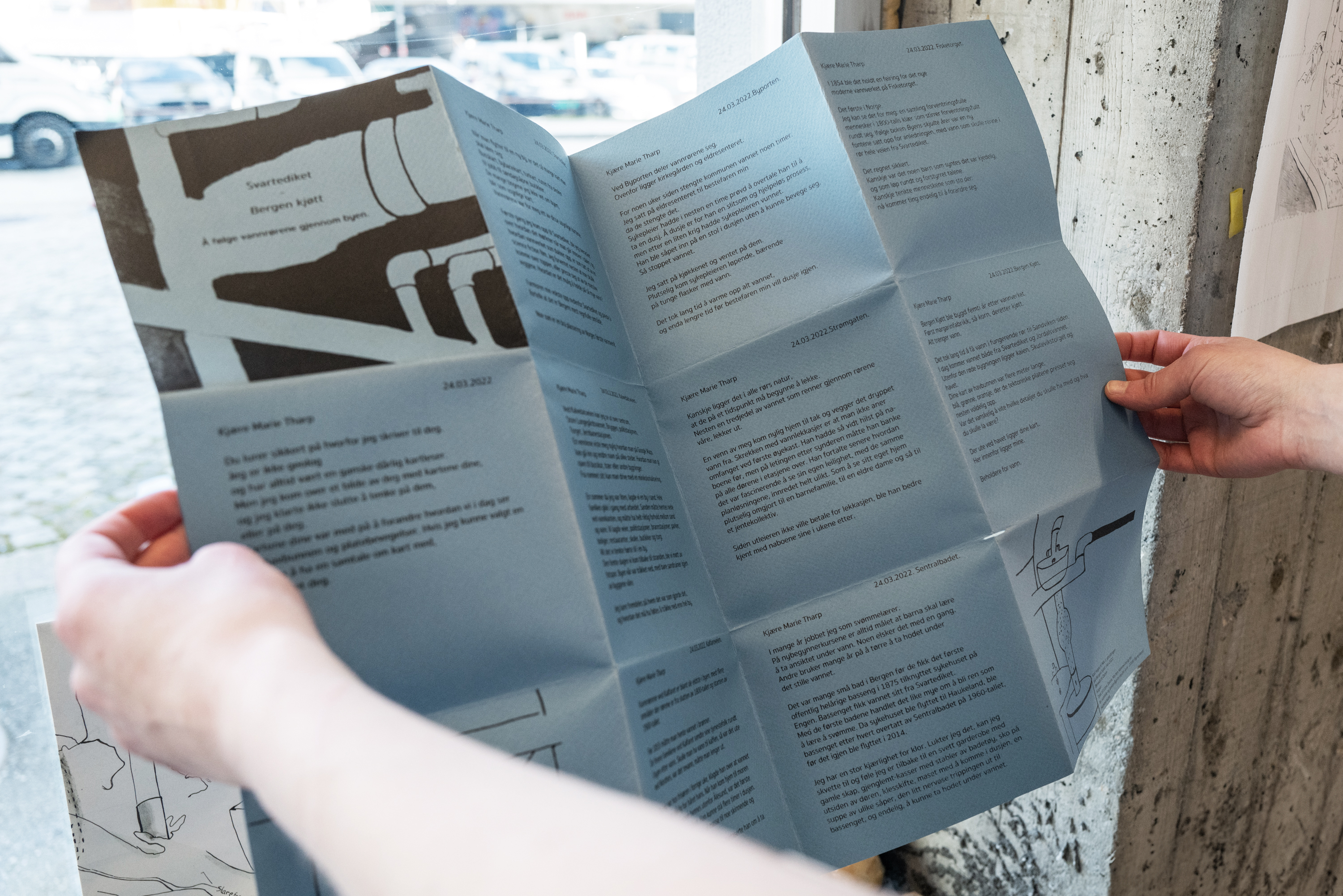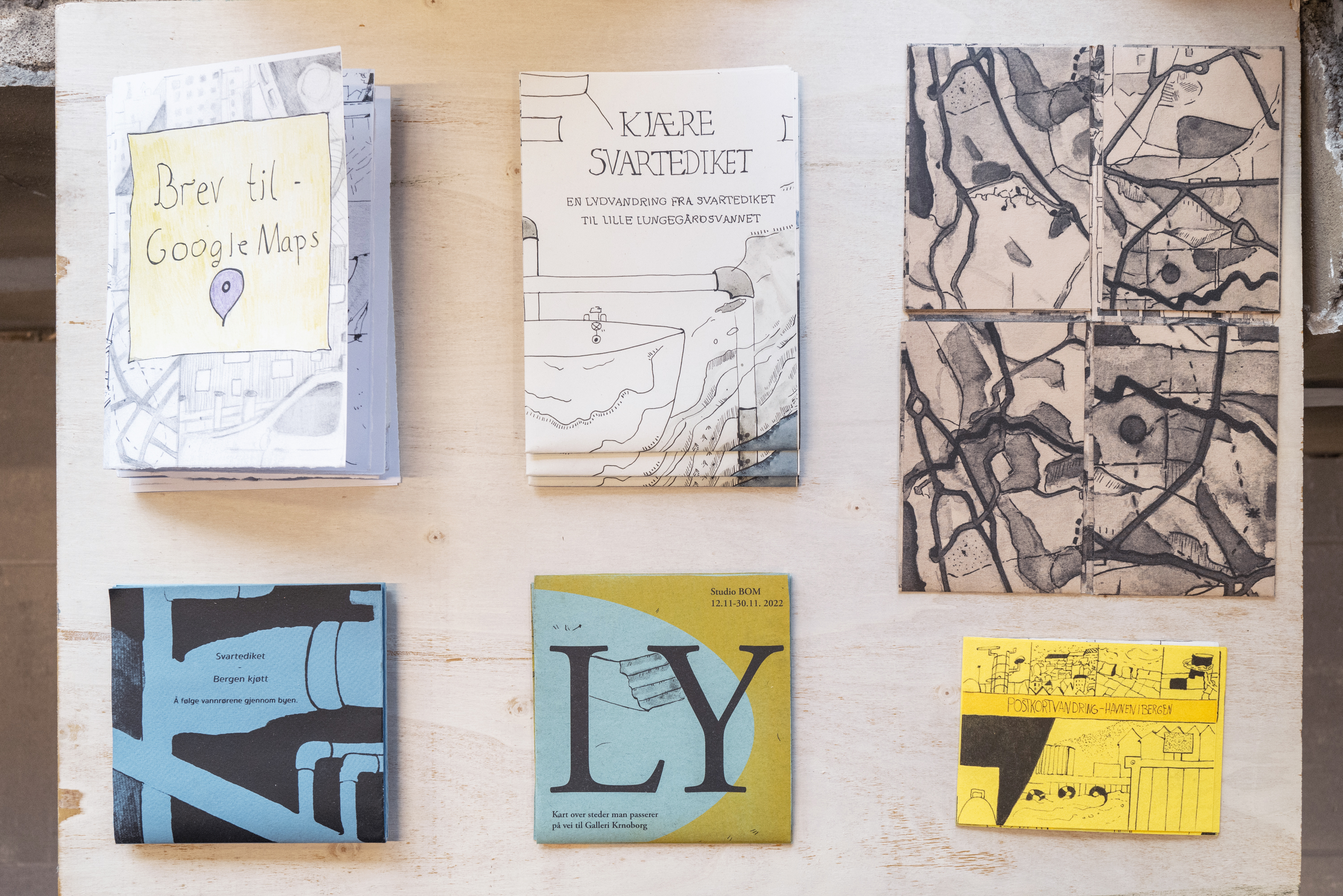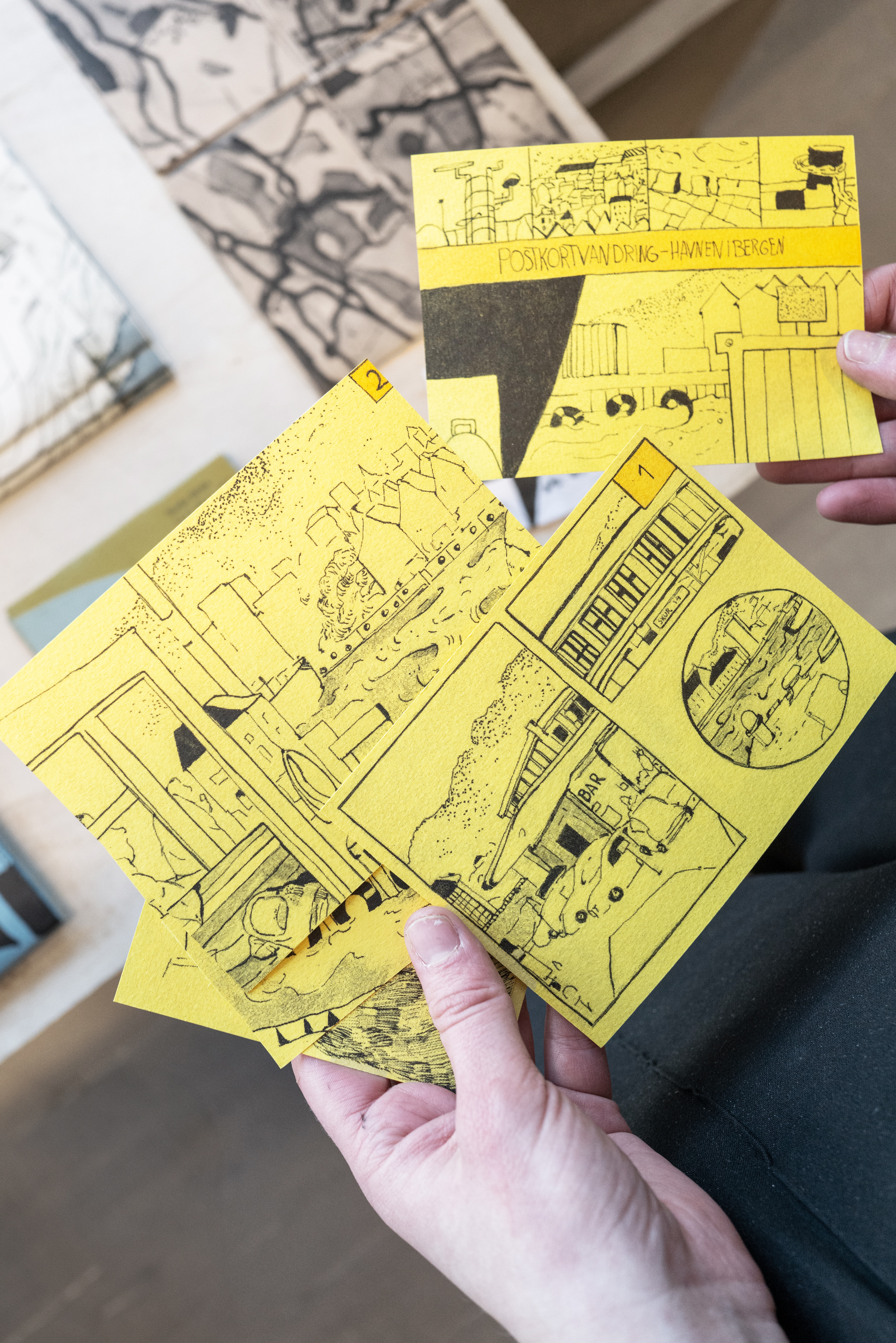Images by Johanne Karlsrud
BENEDICTE DAHM
KIOSKEN STUDIO RESIDENT: APRIL
RESIDENCY & INTERVIEW
01.04.2024 - 28.04.2024
In April, we were excited to welcome Benedicte Dahm as our April resident at KIOSKEN STUDIO. Benedicte spent her time at Kiosken going on walks that hugged Bergen’s harbour - thinking about water, instructions, everyday stories and modes of mapping. At the end of her residency, she opened the space for an exhibition of works in progress and hosted an audio walk around the harbour. She also organised and held a talk with 3 interdisciplinary speakers - Amy Van Den Hooven, Eamon O’Kane and Axel Bache-Wiig - discussing their practices in relationship to mapping.
You can read the interview below alongside documentation for her exhibition - The Agency of Mapping (and Walking) that opened on Wednesday 24th of April.
BENEDICTE DAHM
Benedicte Dahm (1997) is a Norwegian artist working between Bergen and Oslo. She got her BFA from Oslo national academy of the arts KHiO, and her master from the art academy at the University of Bergen.
Benedicte moves between drawing, sculpture, installations, maps/audio-walks, animations and printed matters.
She seeks to make visible the infrastructure around us, and uses storytelling to investigate our everyday objects, local stories and how we move and meet in public and private spaces. In her practice she combines different mediums as a way to create and invite into worlds and meeting spaces: from audio walks that follow the water pipes around cities, to illustration or bigger installations.
KIOSKEN STUDIO
is a unique residency program that spans across the entire field of contemporary art, craft and design. During their residency, artists, designers, writers, musicians, performance artists and filmmakers are invited to work on ideas they want to further develop at Kiosken's premises for a period of four weeks. The public can follow the process through the large shop windows facing the street. KIOSKEN STUDIO is organised through an open call.
Kiosken is an interdisciplinary gallery and project space dedicated to artists, designers and artisans in the region. Through our shop, residency- and exhibition program, we aim to increase the visibility and earning potential of arts, crafts, and design in Vestland.

KIOSKEN IN CONVERSATION: BENEDICTE DAHM
KIOSKEN IN CONVERSATION is a series of interviews and studio visits by writer and curator Ruby Eleftheriotis, that engages with our current exhibiting artists, KIOSKEN STUDIO residents and the Kiosken Shop community.
I interviewed Benedicte in her studio, just a few days before her exhibition opened. We sat surrounded by ceramic pipe-like objects, the beginnings of a wooden sculpture - reminiscent of a notice-board - and a long piece of paper printed with patterns from tiles, that draped down the wall from the ceiling to the floor. We talked whilst watching tour groups and buses pass by the windows, boats coming and going, and clouds gathering around the peaks of the moutains. In this conversation, Benedicte shared with me her process, how she relates to mapping and water, and how to move between the deeply personal and the objective.
R: Ruby Eleftheriotis
B: Benedicte Dahm
Monday 22 April 2024, 13:08

R:
I’m really excited to have a look around the studio… There are so many little clues to what you have been doing. I see a lot of maps…
B:
[laughing], Yes, there are a lot of maps! I have been trying to experiment with new ways of making maps. One work is "Letters to Google Maps" - where I both draw and write letters to google maps, discussing both my relationships with maps, and future and past maps.
Another work is a postcard walk that follows the harbour around Bergen. In this work, I record short personal essays to each stop, so that the viewer can hear it as a sound file on the back of the postcards. I have also been thinking about instructions for walking… and other drawings and objects…
R:
So I assume you have been going on lots of walks, right?
B:
Yeah I have. I walked from, like, Laksevåg through the whole harbour. And then this postcard walk, it will be from here to Skuteviken, with short essays about different stops. The stops are Skur 14, Strandkaiterminalen, skur 8, Bergen havn kontoret, and you know, the small swimming dock by Bergen Kjøtt. So that’s the two main walks I’ve managed to do. And I’ve tried to walk around thinking about ways to play with instructions.
R:
I guess instructions are so personal, like when you ask someone on the street how to get somewhere, everyone usually has completely different directions based on how they relate emotionally to the place, or orient themselves in the place.
What is your process for picking the stops you write about it, is there a criteria or does it come more naturally?
B:
Sometimes it comes spontaneously, but often I have to do the walk first, and then I think back on places that I found interesting, that I want to write about, that I remember. I try to find the places that we pass by in our everyday life but don't pay attention to, and then for me it becomes like a discovery or a game, to try to find out stories about the spaces and then link it to other stories and themes.
R:
Like hidden spaces...
B:
Exactly, for me it is important that they should be sort of hidden or overlooked. I also pick places that make me feel a certain way, that I feel some sort of connection to. It has to trigger something, but I guess I am already looking for something that would work in the narrative I am creating… And that would just be the starting point, and then the texts grow from there.
R:
It sounds like a different way of paying attention, of being in the world.
I actually haven’t read your texts, because they are in Norwegian [laughs], but I would love to one day! Can you tell me about them? Are they research-based, factual, personal, fiction?
B:
The texts are usually a mix of personal, fictive and factual. When I have found the places or themes I want to write about, I will research and collect as many facts and stories I can find about them! Then I will mix them into the narrative that I am creating.
I really want to translate them into English, but I want to do it properly, and up until now I have not been able to do that. But I hope some time in the future!
R:
Translation can make it difficult to pick up on nuances of memory… It would be interesting if you did the walk with someone and they wrote about it as well… have you done that before, as a workshop? Walking together and writing together?
B:
No, but that could be interesting. On the walks, people usually would tell me their own stories about the place or their relationship to it. That is something that really fascinates me, how much a place changes. I can pass by something everyday, and then if someone tells me a story about it, it completely changes the way I see a place, and then changes the way I see the city even.
R:
Yeah, you have all these layers of people's memories and lives.
B:
And it starts from the everyday, like the texts I write can go in whatever direction, but I feel it has to have this everyday physical starting point.
R:
It is like you use the city as an archive, inscribing it with your stories and other peoples stories.
B:
I’m trying to, yes [laughs]. I have been trying to think through new ways to approach my practice… Over the last two years I was working so much with the waterways in Bergen for my Masters degree show. I’ve spent a lot of time since then thinking about how I can push that idea further? And what direction to push it, or what I can take with me from that experience.



Your Masters project was beautiful - it came from a really intimate place didn't it?
B:
Thank you, it was a very personal project. I had just lost two of my grandparents who lived in Bergen. Both of whom I was very close to. Around same time I became interested in the old water pipes in Bergen... The drinking water system is in fact the oldest in Norway. I felt like I could pin-point my family’s stories through the whole water pipe system, and I could tell both local stories and my personal family stories through them. And to follow the drinking water pipes...there was something in me that wanted to follow them through memories and my personal life, rather than just following the system.
And, now the question is how to work with new maps, new stories.
R:
If a project starts from a point that was deeply personal, and responds to a particular moment in your life, how do you follow along with that?
B:
That is what I’m working on. And it has been quite different when writing these postcards, after spending two years on a personal, personal, project. It feels, not empty, but perhaps less deep? I’m trying to figure out how I can link this work to something that will resonate on the same level for me, or maybe some projects will just be without this deeply personal starting point. I guess I have to work until I can find some meaningful connection. Maybe that is what I’m starting here.
R:
I guess it is taking time to work on methods, approaches, and then when the meaningful, personal connection comes, you have a bigger toolkit to work with?
B:
Yes. For example, the walk along the harbour was because I wanted to respond to the area around Kiosken. It comes from the site being nearby, rather than an emotional connection. I decided to test out this postcard walk, but it is more just an idea… like a test. I mean it is a work but…
R:
Perhaps it is research?
B:
Yeah it is like a tool, a new way of looking at instructions. I have also been interested in both the aesthetics of manuals and maps, but also the objects that hold them.
I am very fascinated by these instruction-objects around public spaces- like notice boards or signs. They are like objects for truth.
R:
Like. this sculpture in the corner, it reminds me of a sort of notice board.
B:
Yes! I find them so interesting because they tell you: how should I move in this space? What is this place? They aren`t maps in themselves but they are forms of mapping, props or objects of mapping… It is like a language that we all are used to, and then I find it interesting to see if I can work in this language with a completely different narrative.
R:
What drew you to the waterways, or water in general, in the first place?
B:
It first started with the map-maker Marie Tharp and her maps of the ocean bed, and her stories of not being believed in the 60s, both as a woman and as an artist, so she pushed forward, and how it opens up mapping - the maps are these beautiful things but they also make you see and understand things completely differently. So that is where the water comes from. And the mapping.
I’m thinking about how we all think differently about water… desperately needing it or having too much. How water is both so very personal and intimate and also a super political issue. It is soft, beautiful and terrible, and it is this contrast I find so interesting to work with.
And that's what I wanted to test out a bit on the postcard walk, looking at the sea, looking at the harbour… of trading and the history there, and ideas around travelling on water.
R:
Apart from doing a group walk with the postcards, you will also host a talk, right?
B:
Yes, and the talk has been a very important part of this residency. To be able to invite people in to talk about mapping - it is almost more important than the work, at this point. It is interesting to see some artists who work with maps in a really scientific way, or how the geography field uses maps, and data… and I feel like I do the opposite job, because I am dealing with stories and emotions.
R:
Your approach is not objective, almost entirely subjective, but even a map in the most scientific sense, or google maps, is never objective.
B:
Exactly! That is what I find so interesting to work with. That all maps are simplified and edited. Tools for us to see, discuss and make changes to our environment. And in that process so much is lost and forgotten. I find it interesting how artist can work in the language of maps and mapping, but showing other more personal narratives. Like making the alternative maps that you will never see in the… you know, kommuneplanene [council plans].
And so I am trying to bring this to light, with my version of my narrative.







